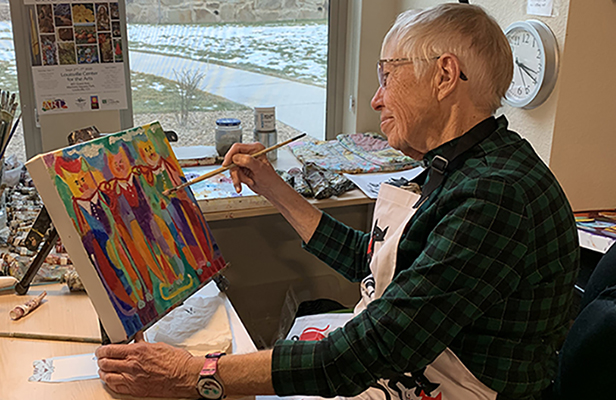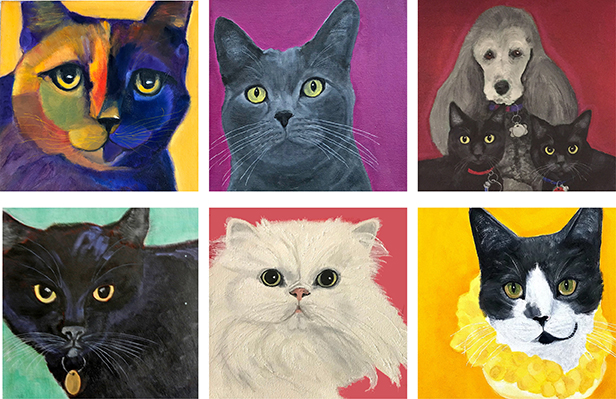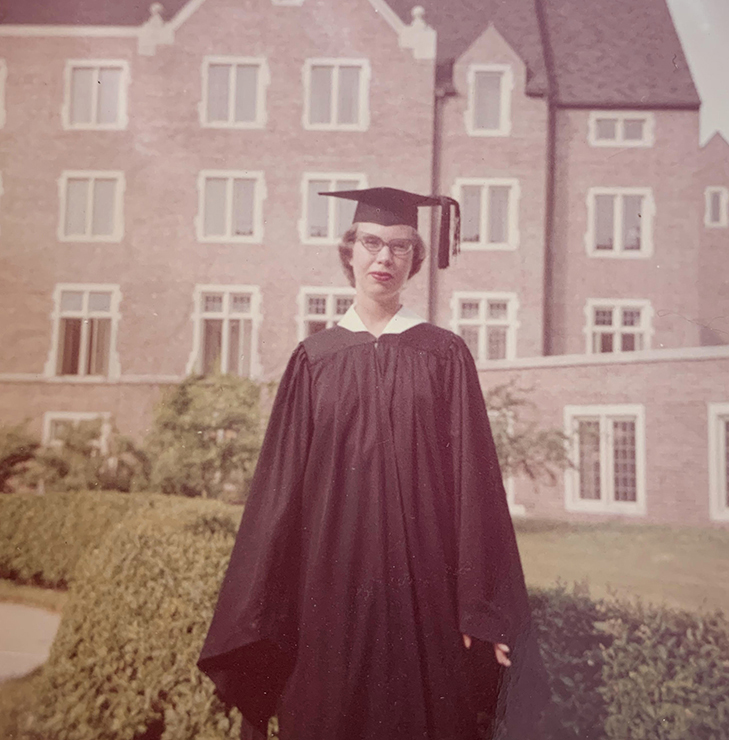
Catch Up With Alumni: Mary Clark
The science of painting cats
Cheryl Pierce

A life's journey in science can branch out into many avenues. Mary Clark, Purdue Physics alumna, graduated in 1959 with a major in Physics and minors in Math and Chemistry. This education gave her a solid foundation for a long and rewarding career in science. She spent 40 years in the computer industry with a career spanning programming, systems operation, database maintenance, web design, and graphic design. All of these avenues prepared Clark for her latest career highlight: painting cats.
Clark was gifted in the sciences. After all, she was granted a Westinghouse Science scholarship from her high school. These scholarships could identify a budding scientist and help them pay their way through to a college degree. But she was also a gifted artist. At the time she attended Purdue, senior skirts and cords were especially popular. Students painted them so that each senior had a unique memento of their stay at Purdue.

Mary drew on her artistic ability to draw and paint skirts for friends and "dorm gals." She was often paid for her talent and this plus her scholarship and a part time job helped her pay her way through her undergraduate degree. Now, after a life-long rewarding career in the computer industry, Clark has circled back to her love of artistry, and it all started by painting those skirts. Now she paints whimsical cats and commissioned pet portraits.
"My first job out of college was at Lockheed in Burbank, CA doing programming related to their aircraft. I then transferred to Lockheed's Space Program in Sunnyvale and programmed. I always did some type of mathematical programming --with the space program, for IBM in San Francisco when they introduced the first disk drive (it was huge!), at UC Berkeley, Lockheed Marietta and more!" says Clark. "After I married, my husband changed jobs to move 'up the ladder' and I moved along, finding jobs in the computer field. Often I was the only woman programmer. Eventually, I ended up learning to setup and maintain databases and websites. Along the way, I obtained two Master's degrees: Marriage and Family Counseling and Leadership and was a Marriage and Family Counselor for a few years; eventually going back to computers."
It's interesting that Clark ended up in a computer programming field. At the time she attended Purdue, the university did not yet have a computer. But an education at Purdue can take a student a long way in the interview process.
"I feel my education at Purdue is what encouraged Lockheed to hire me and train me as a programmer," says Clark. "I love detail and solving problems, so the job was perfect for me. I feel very fortunate to have worked almost 40 years in the computer field; it gave me a sense of confidence with many computer programs."
Clark always had an appreciation for art, even though it wasn't encouraged at home as a child. She has two adult children and always found ways to work arts and crafts into her parenting. Soon she was helping the neighborhood kids with projects. It was a passion that did not conflict with her career in science, it complimented it.
"I use is my computer skills to perhaps draw up an idea in Photoshop or to play with colors in Paint or other programs," says Clark. "I feel very fortunate to have worked almost 40 years in the computer field; it gave me a sense of assurance with many computer programs."
Her scientific training also lent her an eye for detail. Because of her scientific background and interest in painting, Clark obtained a certificate in Botanical Art and Illustration from the Denver Botanic Gardens in 2008. Botanical art is highly detailed plant paintings that are required to be scientifically accurate. After painting botanicals for a few years, her eyes had changed and the detail work added ocular stress so she switched to oil painting, and painting cats.
"A friend talked me into to taking classes at Park Hill Art Club," says Clark. "In my first class, we were to paint ten to twelve paintings in a series. At the time, I was volunteering at a large animal shelter so I choose to paint twelve shelter cats. The rest is history. I am an oil painter and paint primarily cats: whimsical, abstract, and realistic." She still volunteers at the animal shelter and sees cats come in who weren't wanted or left outside as people move. At first, she was mainly painting those shelter cats.
According to Clark, she paints cats to encourage people to see cats other than a throw away object. Now Clark paints all sorts of animals. Her art has been featured in many shows. She has taken part in many art fairs and she currently belongs to a gallery and several art guilds. Though the pandemic has slowed the galleries and shows, Clark's art can be seen in her online gallery, paintingcats.com. She still paints shelter cats in addition to commissioned portraits.
Clark's experience teaches that, though a person may have a variable skill set, it is all connected. Her scientific initiative and artistic talents compliment one another with each whimsical brush stroke.
How to contact Clark about her artwork.